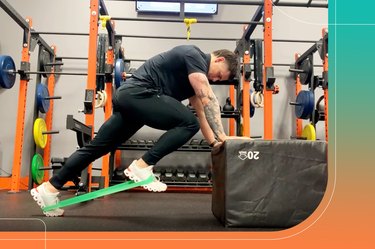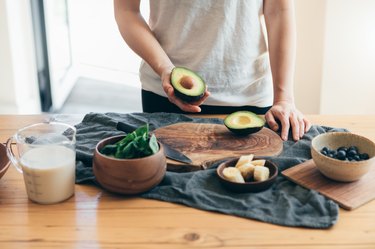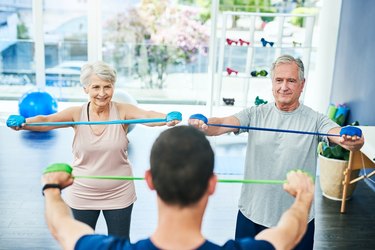
If you want to age well, daily stretching is an effective strategy. Regular stretch sessions can reduce stress and back pain, improve blood flow and, well, stretch the number of healthy years you have.
Specifically, stretching your psoas muscles — which originate in the lumbar spine and attach to the femur in the front of your body — can positively affect your aging process.
Video of the Day
While the psoas may sound new to you, this muscle is involved in many movements. So, if you've ever experienced an achy back or sore hips (who hasn't?), then you've likely felt the wrath of a tight or weak psoas muscle.
But maintaining healthy psoas muscles can make a monumental effect on your mature years, as they play an important part in preventing pain, improving posture and minimizing stress.
One exercise, the knee drive, is in a league of its own when comes to keeping these muscles long, strong and limber.
This body-weight movement — which involves placing your hands on a sturdy surface, like a bench, and driving your knees toward your chest in a slow, controlled motion — both stretches and strengthens the psoas.
You can perform knee drives whenever you have a few free minutes in your day (think: break up long stints of sitting during the workday).
Here, Jake Harcoff, CSCS, founder and head trainer of AIM Athletic, discusses how adding knee drives to your daily routine is linked to longevity.
Tip
Static stretches, like a low lunge, can also provide acute relief for tightness in the psoas, especially after prolonged periods of sitting, Harcoff says.
Still, stretching without strengthening the psoas will only lead to limited results. And, if you’re not careful, can be harmful, too.
“Overstretching weak psoas muscles can result in stretching of the iliofemoral, pubofemoral and ischiofemoral ligaments, which function to prevent hyperextension of the hip,” Harcoff says. “These ligaments are not elastic like the muscles, and, once stretched, will not return to their normal length, causing joint laxity and potential injury.”
That’s why doing knee drives, which both strengthen and stretch the psoas muscles, are your best bet.
How to Do a Knee Drive
- Loop a mini band around the tops of both feet and place your hands slightly wider than shoulder-distance apart on a bench or other sturdy surface.
- Come into a high plank position, keeping your body straight from head to toe and engaging your abs.
- In a controlled movement, drive your right knee toward your chest.
- Return your right leg to starting position.
- Drive your left knee toward your chest.
- Continuing alternating knees back and forth.
Tip
If the mini band makes this move too difficult, ditch it. Instead, start by doing knee drives without the resistance. With time and consistency, your psoas muscles will grow stronger, and you can add the band back in.
Why Knee Drives Are Beneficial for Healthy Aging
1. They Reduce Back Pain
If you have chronic back pain, odds are your psoas muscles may have something to do with it.
A tight or contracted psoas can result in the pelvis tilting forward, causing the lumbar spine to curve inward, Harcoff explains. "Eventually this will lead to soreness and aching and, often, a feeling of compression in the mid to lower back," he says.
Tight psoas muscles — and back pain — become more common with age because we tend to spend more time sitting and being less active, Harcoff adds.
In fact, low back pain is considered one of the most disabling health conditions in seniors, according to an April 2017 review in Scoliosis and Spinal Disorders.
That's why you should incorporate exercises like knee drives, which serve to stretch and strengthen the psoas, into your daily routine as you grow older.
"When feeling especially tight, stretching the psoas can provide short term relief for lower back tightness, and, with strengthening, [you can] eventually get rid of symptoms altogether," Harcoff says.
2. They Decrease Hip Tightness
Knee drives can also decrease tension in your hips, which can become tight in older age thanks to less activity.
Remember, your psoas muscles start at the lumbar spine and extend all the way to the femur in the front of the body. So, when they are tight and short, they can hinder your hips' ability to function healthily.
That's because a tight or contracted psoas muscle usually results in the pelvis dumping forward into anterior pelvic tilt, Harcoff says. And this anterior pelvic tilt will tug on your hips (and your back).
Through exercises like knee drives, "strengthening and gentle stretching of the psoas will allow a contracted psoas to release tension and return to a state of neutral muscle length," Harcoff says. "And once in a neutral state, the pelvis can resume its natural positioning and your hips will feel less tight."
3. They Improve Posture
"A tight or contracted psoas muscle can affect posture by influencing the position of the pelvis," Harcoff says.
Here's why: The pelvis is made up of three bones, the left and right illium and ischiums, which are connected in the middle to the sacrum — the triangular bone below the lumbar vertebrae — at the sacroiliac joint, Harcoff explains.
"If the sacrum is nutated [flexed] forward by an anteriorly tilted pelvis [produced by tight psoas muscles], it will cause an increased lumbar curvature of the spine," Harcoff explains. And this curvature can trigger a damaging domino effect as it typically leads to kyphosis (rounding of the shoulders) in the thoracic spine, he says. That said, tight psoas is just one factor of many that cause kyphosis and lumbar curvature of the spine.
Because stooped posture becomes a bigger problem as we age, we should attempt to do what we can to mitigate it. And performing knee drives — which help to stretch and strengthen the psoas muscles back to a neutral state — can do just that and positively affect your posture.
4. They Relieve Stress
Believe it or not, stretching your psoas muscles can have a profoundly positive effect on your stress level.
That's because the psoas muscles are linked to the vagus nerve, which interacts directly with the brain and is responsible for a multitude of internal functions including digestion, heart rate and breathing, Harcoff says.
In fact, "a tight or weak psoas has been shown to carry stress and keep the body in a sympathetic — fight or flight — state," Harcoff says. "Some research has even made connections between the psoas muscle and post-traumatic stress and anxiety symptoms," he adds.
For example, according to an August 2022 article in StatPearls, the psoas muscles are part of the neural network of the human psycho-somatic experience and are potentially involved in the incidence and relief of post-traumatic stress disorder.
Problem is, persistent stress (and lack of proper stress management) can contribute to chronic inflammation in the body, which plays a role in many diseases such as heart disease and stroke, cancer, diabetes, obesity and more.
"By strengthening and stretching the psoas, one can stimulate the vagus nerve to switch the body into a parasympathetic state [a state of relaxation], which is characterized by rest and digestion," Harcoff says.
More Healthy Aging Tips We Love
Was this article helpful?
150 Characters Max
0/150
Thank you for sharing!
Thank you for your feedback!


